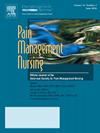The Journey to Initiating Minimal Sedation Across the Children's Institute
IF 1.6
4区 医学
Q2 NURSING
引用次数: 0
Abstract
The pediatric patient population is faced with many anxiety provoking procedures in the medical setting that can have lasting psychological and emotional effects and negatively impact procedural success. A variety of comfort interventions exist for children that can and should be used during procedures to minimize psychological trauma, prevent behaviors that decrease procedural efficacy, improve patient and family experience, and promote the safety of medical staff during procedures. One comfort intervention includes using minimal sedation for select procedures in pediatric inpatient and outpatient settings. At this 400-bed children's hospital within a large, Midwestern, academic health system, a team led by a Pediatric Palliative Care Physician and a Pediatric Clinical Nurse Specialist standardized the use of minimal sedation by utilizing specific medications, doses, and monitoring guidelines.
Minimal sedation is a drug-induced state that allows patients to respond normally to verbal commands, while airway, spontaneous ventilation, and cardiovascular functions are unaffected. Children who have received minimal sedation require only observation and intermittent assessment of their level of sedation. This intervention is safe and effective when implemented with one drug given at one time via one route in controlled healthcare settings. Using a continuous improvement model, which includes a cycle of planning, doing, checking, and adjusting, the team created a practice guideline, an order set within the electronic medical record, and multidisciplinary education to direct both the provider and nursing staff. The guideline outlines key considerations and suggests standard steps for safe administration of minimal sedation. The order set guides providers in choosing one of three benzodiazepines at a set weight-based dose via an appropriate intranasal, oral, or intravenous route. Minimal sedation education includes group presentations to all of the pediatric specialty provider teams and other relevant councils. A module and self-assessment were developed for the pediatric inpatient and outpatient nurses and child life specialists. Next steps for this initiative include continuous improvement and close monitoring during the initial rollout phases. A research study to explore the efficacy and safety of this guideline is in process.
求助全文
约1分钟内获得全文
求助全文
来源期刊

Pain Management Nursing
医学-护理
CiteScore
3.00
自引率
5.90%
发文量
187
审稿时长
>12 weeks
期刊介绍:
This peer-reviewed journal offers a unique focus on the realm of pain management as it applies to nursing. Original and review articles from experts in the field offer key insights in the areas of clinical practice, advocacy, education, administration, and research. Additional features include practice guidelines and pharmacology updates.
 求助内容:
求助内容: 应助结果提醒方式:
应助结果提醒方式:


